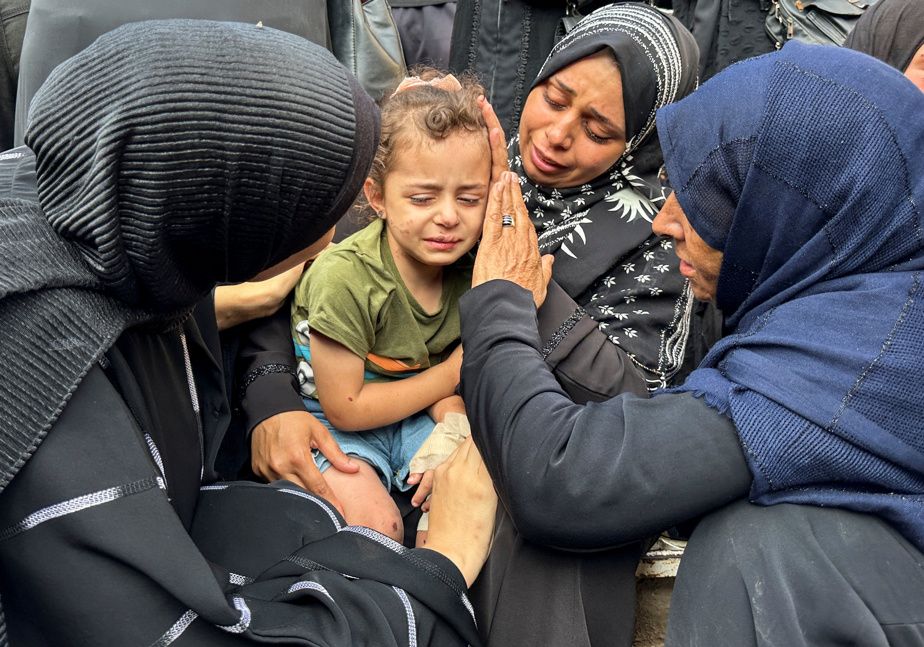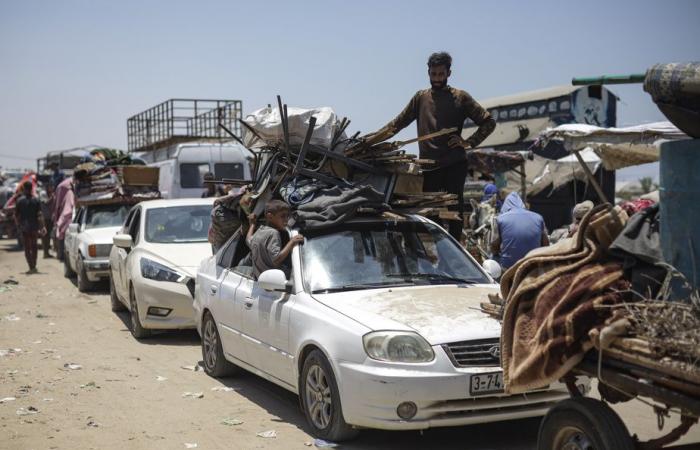Supported by the air force, Israeli soldiers carried out operations against Palestinian Hamas in Gaza City on Friday, pushing tens of thousands of people to flee, in the ninth month of the war which has raised fears of a regional conflagration.
Published at 6:15 a.m.
Updated at 3:55 p.m.
The army began an operation in Shujaiya on Thursday with artillery and helicopter fire. It reported the “presence of terrorists” and “terrorist infrastructure”. Soldiers entered the area and military aircraft targeted “dozens of sites” belonging to Hamas.
Columns of smoke rose above Shujaiya after airstrikes and shelling, an AFP correspondent said.
The Civil Defence and witnesses reported “numerous deaths”.
“Tens of thousands of civilians” fled the area, the Civil Defense said, after a call from the army to evacuate.
” That’s enough ”
” That’s enough ! […] We have lost our children and our homes, and we continue to flee from one place to another,” said a Palestinian woman as she left the area.
“I saw a tank in front of the Chouhada mosque which was shooting [sur des cibles]”My parents and my sister were stuck in the house and I have no news from them. There were martyrs in the streets,” said Abdelkarim al-Mamlouk, a Gaza resident.
Israeli strikes targeted other areas of northern Gaza, “eliminating dozens of terrorists hiding in schools of UNRWA,” the U.N. agency for Palestinian refugees, the military said.
In the center of the Gaza Strip, medical sources reported three deaths including a girl in Deir el-Balah and artillery fire was heard in Nousseirat. In the south, artillery fire targeted Khan Younes and Rafah.
PHOTO BASHAR TALEB, AGENCE FRANCE-PRESSE
A Palestinian inspects the damage to a building in Deir al-Balah destroyed following an Israeli bombardment of Deir al-Balah on June 28.
Mohammad al-Mughair, a civil defense official, told AFP that Israeli forces were advancing in western Rafah and targeting his agency’s headquarters.
“We were targeted, [les tirs] causing damage to two fire trucks, an ambulance, and a small excavator used to pull the injured out from under the rubble,” he said, adding that members of the Civil Defense were injured.
On May 7, Israeli troops launched a ground offensive in Rafah, then presented by Israel as the last major Hamas stronghold. But fighting has resumed in several other regions, especially in the north where pockets of Hamas remain.
“Disastrous” conditions
The major Israeli offensive in Gaza was triggered by an unprecedented attack by the Islamist movement against Israel on October 7 which resulted in the deaths of 1,195 people, mostly civilians, according to an AFP count based on data Israeli officials.

PHOTO BY DOAA ROUQA, REUTERS
Mourners console a little girl during the funeral of Palestinians killed by Israeli strikes in Deir al-Balah on June 28.
During the attack, 251 people were kidnapped, 116 of whom are still being held in Gaza, of whom 42 died, according to the army.
Israel has vowed to destroy the Islamist movement, which has been in power in Gaza since 2007 and which it considers a terrorist organisation, as do the United States and the European Union.
Its offensive on the Gaza Strip has so far killed 37,765 people, mostly civilians, according to data from the health ministry of the Hamas-led Gaza government.
The war has caused a humanitarian catastrophe in the small Palestinian territory of 2.4 million inhabitants, besieged by Israel since October 9: water and food are lacking and the health system is on its knees.
A total of 32 of the 36 hospitals in the Gaza Strip have been damaged since October 7, and 20 of them are now out of service, according to figures released by the WHO on Friday.
UNRWA mission officer Louise Wateridge described living conditions in the territory as “dire” on Friday.
In the middle of the waste
Residents are living in ruins of buildings or tents around a gigantic pile of waste, she told reporters in Geneva, via video link from the center of the Gaza Strip.
“There is no water, no sanitation, no food,” she added of Khan Younes.
PHOTO JEHAD ALSHRAFI, ASSOCIATED PRESS
Palestinians arrive in Khan Yunis after fleeing an Israeli ground and air offensive in the neighboring town of Rafah on June 28.
Fears that the conflict could spread to Lebanon have grown.
The day after the start of the war, the powerful Lebanese movement Hezbollah opened a front with Israel in support of Hamas, and since then, exchanges of fire in the border area have been almost daily and sometimes very intense.
Hezbollah said Friday it had launched several attacks on Israeli military positions near the border, and announced the death of one of its fighters, killed by Israeli fire.
The official Lebanese agency, for its part, reported the death of three people, including two Palestinians, in an Israeli strike on the village of Kfar Kila.
In northern Israel, rocket warning sirens sounded several times, according to the army, which later said that three drones had been launched from Lebanon before falling in the Galilee, causing no casualties.








